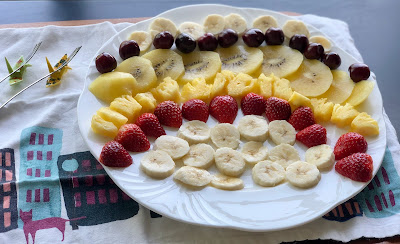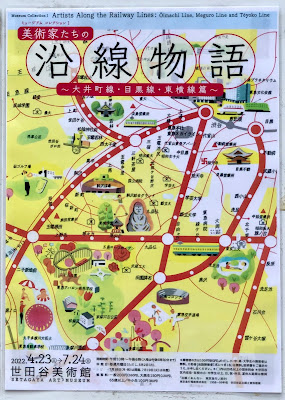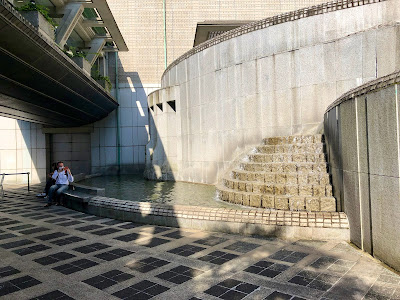目次 / Contents
1) 2つの展覧会 / Two Exhibitions
2) 美術館のサイトから / From Museum Website
3) 冊子 / Leaflet
4) 建築 / Architecture
A. 内井 昭蔵 / Shōzō Uchii
B. サンクン・ガーデン / Sunken Garden
C. お堀の庭 / Moat Garden
D. 他のサイトより / From Other Websites
5) セタビカフェ / SeTaBi Café
1) 2つの展覧会 / Two Exhibitions
 |
2つの展覧会
Two Exhibitions |
ピーターラビット展については下記。/ About Peter Rabbit Exhibition, below.
2) 美術館のサイトから
From Museum Website
ピーターラビット展の会場で撮影禁止なのは、日本で初公開される原画著作権の保護だと思いました。
けれども、美術家たちの沿線物語展の会場も撮影禁止だったので、
この美術館の基本的な姿勢が撮影禁止であることに気がつきました。
 |
左の模型:古仁所邸 (コニショテイ)
1936年竣工
現存していません。
右のジオラマ:等々力渓谷
Left Model : Konisho House
Completed in 1936.
It does not exist.
Right Diorama : Todoroki Valley
|
From Museum Website
I thought that photography was prohibited at the venue of the Peter Rabbit exhibition as a way to protect the copyright of the original artwork, which was exhibited for the first time in Japan.
However, photography was prohibited at the venue for the artists' exhibition of stories along the railway lines, so I realized that the basic stance of this museum is that photography is prohibited.
I borrowed 3 photographs of the venue from the museum website and show them here.  |
寺山修司 のコーナー
久々に寺山 修司 (テラヤマシュウジ/ 1935 -1983) 関連の
ものを見ました。
懐かしさと新鮮さを感じました。
寺山修司は前衛演劇グループ・"天井桟敷" を主宰していました。
Shūji Terayama's Corner
It's been a while since I saw something related to
Shūji Terayama (1935 -1983).
I felt nostalgic and fresh.
Terayama was a Japanese avant-garde poet,
dramatist, writer, film director, and photographer.
Terayama presided over the avant-garde
theatre group "Tenjō Sajiki". |
"大正から昭和初期の郊外開発に端を発する東急大井町線、目黒線、東横線は、今日にいたる世田谷の街並みを形づくってきました。
本展では村井正誠 (ムライマサナリ / 1905 - 1999) や 宮本三郎 (ミヤモトサブロウ / 1905 - 1974) など、沿線に住んだ美術家や文化人たちの創作と交流の足跡を辿ります。 また小コーナーでは「黒船館をめぐって―吉田正太郎と小川千甕」として、新潟県柏崎市にある「黒船館」関連作品を展示いたします。"
吉田 正太郎 (ヨシダショウタロウ / ? -?) は、新潟県柏崎市内の'花田屋 (呉服店)' の三代目)で、幕末開港資料を収集しました: ★。
その資料は、柏崎市の '黒船館' に保存されています。
小川 千甕 (オガハワ センヨウ / 1882 - 1971)は、京都市出身の仏画師・洋画家・漫画家・日本画家です。  |
黒船館をめぐって - 吉田正太郎と小川千甕
About the Kurofunekan - Shotaro Yoshida and Chimitsu Ogawa |
"The Tokyu Ōimachi, Meguro, and Tōyoko lines, rooted in the development of the suburban Tokyo during the Taisho and early Showa Period, have exerted a lasting influence on the Setagaya cityscape.
This exhibition traces the work and relationships of artists and other cultural figures who lived along the train lines, including
Murai Masanari (1905 - 1999), and
Miyamoto Saburo (1905 - 1974) ."
"In the small corner, we exhibit "About the Kurofunekan - Shotaro Yoshida and Senyou Ogawa" which related to "Kurofunekan" in Kashiwazaki City, Niigata Prefecture."
Shotaro Yoshida (? -?) was the third generation owner of 'Hanadaya' (kimono shop) in
Kashiwazaki City,
Niigata Prefecture, and collected materials on the opening of the port at the end of the Edo period:
★.
The materials are kept in '
Kurofunekan' in Kashiwazaki City.
Senyo Ogawa (1882 - 1971) was a Buddhist painter, Western-style painter, manga artist, and Japanese-style painter from Kyoto.
3) 冊子 / Leaflet
 |
東京急行電鉄路線図
Tokyu Railway Route Map
画像は下記より / This from below
★ |
 |
② : 私の母校の多摩美術大学の紹介がされています。
③ : 等々力駅周辺の住宅開発と
居住していた美術家が書かれています。
② : It introduces my alma mater, Tama Art University.
③ : It describes the housing development around Todoroki Station
and the artists who lived there.
|
 |
④ : 九品仏浄真寺 (クホンブツジョウシンジ) の参道前に
大井町線・九品仏駅が開業しました。
1972年、東横線・自由が丘駅、開業。
自由が丘周辺に多くの文化人が住まうようになりました。
私鉄の中では、私は東横線が最も馴染みがあります。
⑤ : 1923年目黒線・奥沢駅開業。
世田谷美術館の設計者、
内井 昭蔵 (ウチイ ショウゾウ / 1933 - 2002)は
奥沢でい生まれ育ちました。
④ : In front of the approach to Kuhonbutsu Joshin-ji Temple Among the private railways, I am most familiar with the Toyoko Line. Many cultural figures began to live around Jiyugaoka. Shōzō Uchii (1933 - 2002), the designer of the Setagaya Art Museum, was born and grew up in Okusawa. |
 |
⑥ : 洋画家、宮本 三郎 (ミヤモトサブロウ / 1905 - 1974)は、
自由が丘から西小山駅 (1928年開業) の住宅街に
結婚を機に引っ越してきました。
リトグラフの刷り師、
女屋 勘左門 (オナヤ カンザエモン / 1903 -1987) は
リトグラフ工房を作り、
猪熊 弦一郎 (イノクマゲンイチロウ /1902 -1993 )
の注文を受けました。
⑦ : 不動前駅~目黒駅 ; 多くの版画家、洋画家が住みました。
moved from Jiyūgaoka to the residential area of when he got married. Lithographer, Kanzaemon Onaya (1903 -1987) established a lithograph studio and received orders Many printmakers and Western-style painters lived here. |
 |
⑧ : 学芸大学駅 - 祐天寺駅
左ページ、上の写真は、1962年の学芸大学駅です。
私は英国留学前、イラストレイターであったときに、
学芸大学駅近くに住みました。
下の写真は、前述した寺山修司です。
⑨ 渋谷駅 ; 1927年開業。
開業初日、一人も乗降客がいませんでした!
Left page, top photograph is Gakugeidaigaku Station in 1962. Before studying in England, when I was an illustrator, I lived near Gakugeidaigaku station. The lower photograph is Shuji Terayama, mentioned earlier. ⑨ Shibuya Station ; Opened in 1927. On the first day of opening, there was not a single passenger on board! |
 |
『郊外電車と沿線の名所』・抜粋
今 和次郎 (コン ワジロウ / 1888 -1973) 著
今 和次郎は、建築学者、民俗学研究者で、
考現学 (コウゲンガク) の第一人者です。
考現学は、現代の世相を分析・研究する学問です。。
分析・研究というと批判的な内容に思いがちですが、
ここに載せられている文章は、前向きで明るく書かれています。
"Suburban trains and sights along the line"
Excerpt in Japanese
By Kon Wajirou (1888 -1973)
Wajiro Kon is an architect, a researcher of folklore,
and a leading expert in "modernology": kogengaku. Modernology is a field of study that analyzes and
researches contemporary social conditions.
When I (or we) think of analysis and research,
I (we) tend to think of critical content,
but the sentences posted here are forward-looking
and brightly written. |
 |
沿線居住作家一覧
List of Artists Residing Along the Railway Line
 |
東横沿線に住んでいた私には、大変興味深い冊子です。
鎌倉にも多くの文化人が住んできましたが、世田谷は文化の幅が広く、関係する作家もより多いように感じました。
It is a very interesting leaflet for me who has lived along the Toyoko line.
Many intellectuals have lived in Kamakura, but Setagaya has a wider range of culture, and I felt that there are more artists involved.
4) 建築 / Architecture
A. 内井 昭蔵 / Shōzō Uchii
前述したように、建物は、内井 昭蔵 (1933 - 2002) が設計しました。
竣工は、1986年です。
下記は、彼のWikiの項に載っていた彼の建築の写真からの私の印象です。
内井 昭蔵 は、個性的で入り組んだ建築をする方だと思いました。
その土地の特色に寄り添う建物をデザインするようにも感じます。
この美術館の場合は、砧公園です。
 |
| 入り口 / Entrance |
Shōzō Uchii
As mentioned above, the building was designed
Construction was completed in 1986.
Below are my impressions from photographs of his architecture on Japanese Wiki.
I thought that Shōzō Uchii is a person who does unique and intricate architecture.
I also feel that he designs buildings that are close to the characteristics of the land.
In this case this museum suits Kinuta Park.
 |
世田谷美術館 〒157-0075東京都世田谷区砧公園1-2
Setagaya Art Museum 1-2, Kinuta-koen, Setagaya-ku, Tokyo, 157-0075 |
B. サンクン・ガーデン / Sunken Garden
"サンクン・ガーデン"と呼ばれる空間が、私はおもしろいな〜と思いました。
屋内は展示品がメインとなるので、建築としての主張はあまりできないのかもしれません。
"サンクン・ガーデン"は、建築家が自分の腕をふるえる場所なのでしょう。
I thought the surrounding space called "Sunken Garden" was interesting.
The interior is mainly for exhibits, so it may not be possible to make a lot of claims as architecture.
The "Sunken Garden" is a place where the architect can show his ability.
ここの空間は、英国のウオールマ城のお堀を思い起こします。
The space here reminds me of the moat of Walmer Castle in Britain.
ウオールマ城のお堀については下記。
About the moat of Walmer Castle, below.
C. お堀の庭 / Moat Garden
ウオールマ城のお堀の写真をいくつか下に載せます。
Below are some pictures of the moat of Walmer Castle.
 |
Moat Garden
'Moat'とは、'お堀'のことです。 |
D. 他のサイトより / From Other Websites
美術館の建築についての説明をしているサイトを見つけました。
そこでの説明が面白かったので、ご興味がある方はアクセスしてみてください。→★
先に私は印象を書きましたが、このサイトでは具体的に説明しています。
 |
画像は下記より / This from below
★ |
I found a site explaining about the Museum architecture.
The explanation there was interesting, so if you are interested, please access it. →★(sorry, only in Japanese)
Earlier, I wrote about my impressions, but this website explains in detail.
 |
"サンクス・ガーデン" の噴水
噴水というよりも滝?
'日本庭園の人工の滝' を西洋風にした感じです。
Fountain of "Thanks Garden"
A waterfall rather than a fountain?
I feel it is a Western style of 'artificial waterfall in a Japanese garden'.
画像は下記より / This from below
★ |
.jpg) |
カフェへ向かう入り口
"サンクス・ガーデン" はカフェに繋がっています。
カフェのテーブルもガーデンにいくつかあります。
Entrance to the Cafe
"Thanks Garden" is connected to the cafe.
There are also some cafe tables in the garden.
画像は下記より / This from below
★ |
7) セタビカフェ / SeTaBi Café
私たちは、展覧会の前後に利用しました。
 |
Rのケーキ
Yよりも少し早く美術館に到着したので、カフェへ行きました。
Rはケーキセット、私は飲み物だけいただきました。
R's Cake We arrived at the museum a little earlier than Y, so we went to the cafe. R had a cake set, I only had a drink. |
The museum's cafe is "SeTaBi Café" on the first basement floor.
We used it before and after the exhibitions.
 |
Rの蕎麦粉クレープ
2度目は展覧会見学後に、3人でカフェを利用しました。
Rは蕎麦粉のクレープ、ケーキ、飲み物、
私は、飲み物だけいただきました。
Rの食の問題にも対処していただきました。
ありがとうございました。
R's Buckwheat Crepe The second time, after visiting the exhibitions, the three of us used the cafe. R had a buckwheat crepe, a cake, and a drink, and I only had a drink. They also took care of R's food problem. Thank you very much. |
 |
Yのケーキ / Y's Cake
|
 |
カフェの時計
お茶の時間ですね。
Cafe Clock
It's tea time. |

















































.jpg)



